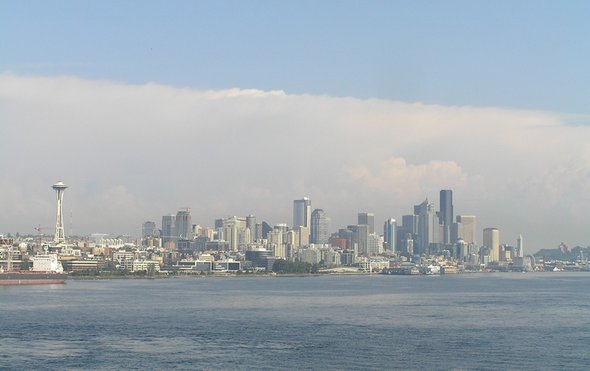(单词翻译:单击)
听力文本
This is Scientific American — 60-Second Science. I'm Christopher Intagliata.
The big hurricanes last summer—Harvey, Irma and Maria—knocked out internet service for many residents. But another threat to the internet is just plain old sea level rise.
"Uh, yeah, I mean some is already happening." Carol Barford, a biogeochemist at the University of Wisconsin–Madison. "There's a lot of data out there that shows that sea level on the coast is rising."
And that, she says, means big problems for internet connectivity in major coastal cities like New York, Seattle and Miami. Barford and her colleagues forecast that danger using a map of global internet networks, along with sea level rise data from NOAA.
"So there are two maps, where's the internet stuff and where's the flooding. And when they're superimposed, where they coincide, there are problems."

Using NOAA's extreme sea level rise estimate, recommended for forecasts involving long-term infrastructure like this, the researchers say that 15 years from now, 4,100 miles of fiber-optic cable could be underwater. And 1,100 internet hubs could be surrounded by water. And remember, our land-based infrastructure isn't waterproof, like transoceanic cables are.
"Seawater comes in, and cabling is not meant to work underwater. So signals will be interrupted and dropped. The actual infrastructure itself might deteriorate." The researchers presented the peer reviewed findings at the Applied Networking Research Workshop in Montreal this week.
They also write that large internet service providers including AT&T, CenturyLink and Inteliquent face the greatest risk. So if these predictions play out, internet companies need to harden their networks soon, they say. Or we could lose service during the emergency—right when we need it most.
Thanks for listening for Scientific American — 60-Second Science. I'm Christopher Intagliata.
参考译文
这里是科学美国人——60秒科学。我是克里斯托弗·因塔利亚塔。
“哈维”、“厄玛”和“玛利亚”等去年夏天发生的大飓风导致许多居民的网络服务中断。但互联网面临的另一个威胁是我们经常提到的海平面上升。
“嗯,是的,有些已经发生了。”威斯康星大学麦迪逊分校的生物地球化学家卡罗尔·巴福德说到。“有大量数据显示,海岸的海平面正在上升。”
她说,这意味着纽约、迈阿密和西雅图等主要沿海城市的互联网连接面临着巨大问题。巴福德和同事利用全球互联网网络地图以及美国国家海洋和大气局(NOAA)的海平面上升资料,预测了这一风险。
“有两份地图,一份标明了互联网设备的位置,另一份显示发生洪水的区域。把两份地图重叠,哪里有重合,哪里就有问题出现。”
美国国家海洋和大气管理局的极端海平面上升数据,适用于这种长期基础设施的预测,基于这一估计,研究人员表示,15年之后可能有4100英里的光纤电缆会被水淹没。1100个互联网中心可能被水包围。记住,我们的路基基础设施并不防水,就像越洋电缆一样。
“海水涌上来,电缆不能在水下工作。因此信号就会被中断和切断。基础设施自身的情况可能会恶化。”研究人员在本周于蒙特利尔举行的应用网络研究研讨会上,发表了经过同行评议的研究结果。
他们在研究中还表示,AT&T、世纪电信和Inteliquent等大型互联网服务提供商面临的风险最大。他们说,如果这些预测成真,那互联网公司需要尽快加强网络系统。否则,我们可能会在紧急情况下——也就是我们最需要网络的时候——失去网络服务。
谢谢大家收听科学美国人——60秒科学。我是克里斯托弗·因塔利亚塔。
译文为可可英语翻译,未经授权请勿转载!
重点讲解
重点讲解:
1. knock out 摧毁;使瘫痪;
A storm has made roads treacherous and knocked out power.
一场暴风雨致使公路隐患重重且电力瘫痪。
2. be surrounded by 围绕;环绕;
The small churchyard was surrounded by a rusted wrought-iron fence.
不大的教堂墓地周边围着一圈生锈的熟铁栅栏。
3. come in (潮)涨;
The tide usually starts to come in at about six o'clock.
通常六点钟就开始涨潮了。
4. play out (使)(戏剧性的事件)逐渐发生;(使)展开;
I know it's not how you'd want us to play out.
我想这和你对我们预期的有所不同。


